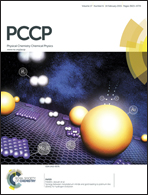The atomistic mechanism of hcp-to-bcc martensitic transformation in the Ti–Nb system revealed by molecular dynamics simulations
Abstract
Applying the constructed Ti–Nb potentials, molecular dynamics simulations were conducted to investigate the martensitic transformation of Ti100−xNbx alloys (x = 5, 10…25) from the α′ phase (hcp) to the β phase (bcc). It is found that the transformation involved four phases, i.e. α′, α′′, fco (face-centered orthorhombic), and β phases. The structures of the obtained phases exhibit consistency with experimental data, verifying the validity of atomic simulations. The simulations not only revealed the processes of atomic displacements during the transformation, but also elucidated the underlying mechanism of the martensitic transformation at the atomic level. The martensitic transformation incorporates three types of coinstantaneous deformations i.e. slide, shear as well as extension, and the subsequent lattice constant relaxation. Furthermore, according to the proposed mechanism, the crystallographic correlation between the initial α′ phase and the final β phase has been deduced. The simulation results provide a clear landscape on the martensitic transformation mechanism, facilitating our comprehensive understanding on the phase transition in the Ti–Nb system.


 Please wait while we load your content...
Please wait while we load your content...